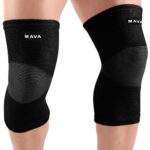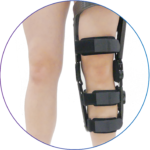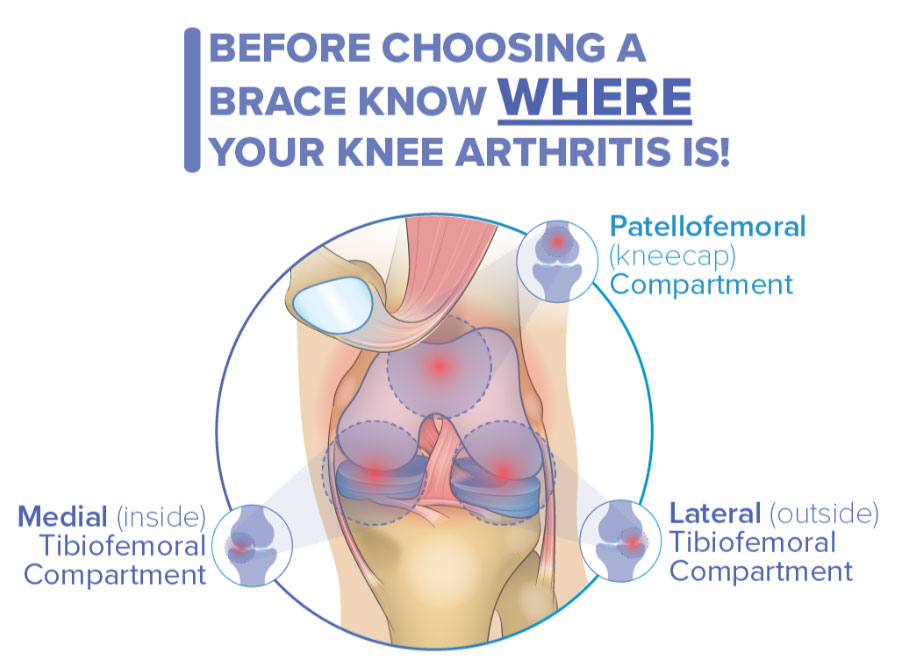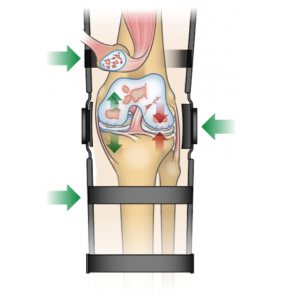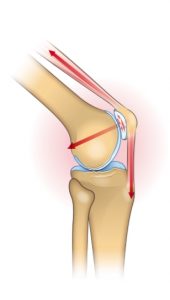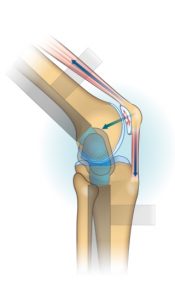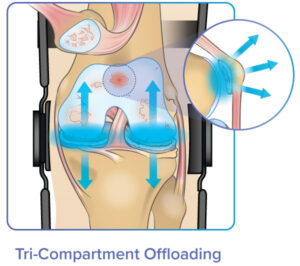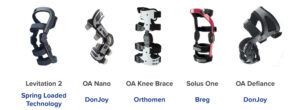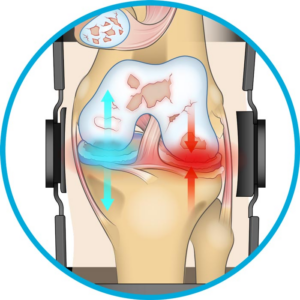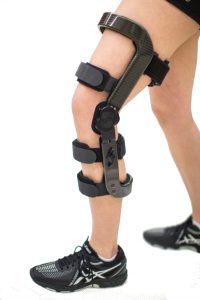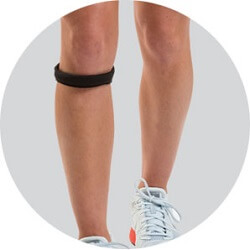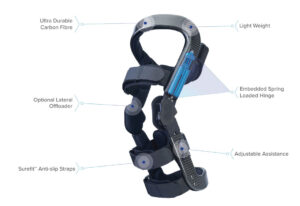
Introduction
Knee braces are an excellent choice of treatment option for a variety of knee injuries and conditions. They are generally non-invasive, low-risk, and cost-effective. The best knee braces can provide significant benefits by helping to support the joint, reduce pain, and improve stability and mobility. However, brace design, function, and quality vary widely. Choosing the right brace for your needs can be difficult, especially with the overwhelming amount of information on the internet. That’s why we’ve put together this comprehensive guide to answer all of your knee brace-related questions. We’ll break down everything you need to know about choosing a knee brace, so you can make an informed decision about which brace is best for you.
Types of Knee Brace
Before choosing a knee brace, it may be helpful to learn about the different types of braces available. Most knee braces can be broadly categorized as hinged or non-hinged. As the name suggests, hinged braces incorporate hinges, which allow the brace to provide more support and stability to the knee, and promote proper alignment. Non-hinged braces offer less support but are still useful in many situations. Within these two categories, there are several different types of braces, each designed for a more specific purpose.
Hinged Knee Braces
- Prophylactic braces: Typically worn by athletes to prevent knee injuries, they are designed to help stabilize the joint and protect the knee ligaments.
- Functional braces: Protect and support the knees after injury or reconstructive surgery. Some are designed to treat specific injuries (ex. an ACL functional brace is designed to support the ACL and prevent movements that could cause re-injury).
- Offloader braces: Specifically designed to treat knee osteoarthritis, offloaders are designed to redistribute and/or reduce forces in the joint to protect damaged bone cartilage. They can also be used to help treat meniscus injuries.
- Spring braces: Incorporate springs into the hinge to absorb body weight as the knee bends. The most powerful spring braces also assist your leg muscles by releasing stored energy as you straighten your leg. Some of the best offloader braces use spring technology to reduce load across the entire the knee.
More information about hinged braces can be found in this resource – The Best Hinged Knee Brace for Your Needs.
Non-Hinged Knee Braces
- Compression sleeves: Provide warmth and compression to support the knee, increase proprioception, and decrease pain, stiffness, and inflammation. They are mainly used by individuals with mild knee pain or injury who want to stay active. They may also be used in the final stages of injury rehabilitation when returning to exercise and sports. You can learn all about compression braces here.
- Knee straps: Apply pressure to the patellar tendon (just below the knee cap) to relieve pain from injuries such as jumper’s knee and runner’s knee.
For more information on how all of these braces can help relieve knee pain, check out this resource – The Best Knee Brace for Pain.
Features of a High Quality Knee Brace
Here are a few important things to look for in any knee brace:
- Comfort and Breathability: You should be able to wear a brace comfortably for extended periods. A brace should also use breathable materials for use during exercise or sports activities.
- Lightweight and Streamlined Design: High quality braces are neither heavy or bulky, and can be fitted properly to your leg dimensions to help avoid discomfort. The best knee braces will feel almost like an extension of your leg so that after a while, you forget it’s even there.
- Adjustability and Customization: Some of the more expensive braces can be custom-fitted to your leg for a perfect fit. However, any high-quality brace should have adjustable features like straps, dials, or different options for padding so you can customize the brace for your needs.
What's Causing Your Knee Pain?
The next sections outline the best type of knee brace for various common knee problems. Select from the list below to jump to the section most relevant to you.

There are a few different types of knee brace that can help you manage your knee osteoarthritis (OA). Below, we break down which one to choose depending on the severity and pattern of your OA.
BEST KNEE BRACE FOR MILD OA: COMPRESSION SLEEVE
Research shows that compression sleeves can relieve pain and improve function for OA patients [1], so it’s a good option to help manage your symptoms if you have mild OA. The warmth and compression it provides can reduce pain and stiffness and improve your sense of stability, especially during and after exercise. A sleeve will not provide as much support or pain relief as an offloader knee brace because it lacks a hinge, so for moderate to severe OA it probably won’t be very effective.
Best Knee Brace for Moderate or Severe OA: Offloader Brace
Reducing joint load is one of the preferred treatments for knee osteoarthritis. As a result, OA knee braces are designed to offload your knee by reducing or redistributing pressure in the joint. This protects the cartilage and decreases bone on bone contact, which helps to relieve pain and restore mobility.
There are three compartments of the knee where osteoarthritis can occur. OA can affect one compartment or multiple compartments at the same time. It’s important to understand which compartments of your knee are damaged because that will determine which type of offloader brace you need.
There are 2 main types of offloader braces:
- Uni-compartment offloader – reduces pressure on one side of the knee by shifting weight to the other side
- Tri-compartment offloader – reduces pressure across the entire knee, including under the knee cap, by absorbing body weight as the knee bends.
We have a couple of useful resources if you want to read in-depth about knee braces for osteoarthritis:
- The Best Knee Brace for Osteoarthritis
- The Best Knee Brace for Bone on Bone Pain
- The Best Anti-Gravity Knee Brace
Which Offloader Brace is Right for You?
It depends on what pattern of OA you have. The best offloader knee brace for each pattern of OA is outlined below.
Uni-compartmental Tibiofemoral OA
In this case, only one tibiofemoral compartment of the knee is damaged. A uni-compartment offloader brace shifts pressure away from the damaged compartment towards the healthy knee compartments. This provides relief from symptoms and can allow you to move more freely without experiencing painful bone on bone contact. Offloaders are a cost-effective and non-invasive way of reducing pain and improving functional ability [2,3].
The diagram above shows how an offloader brace alters knee alignment and the distribution of force in the joint. In this case, the brace is relieving pressure on the medial tibiofemoral compartment and shifting pressure to the lateral side of the knee.
Patellofemoral OA
Over half of knee OA cases involve the patellofemoral (PF) compartment [4] which is located under the knee cap. Conventional offloader braces can’t relieve pressure under the knee cap, so a tri-compartment offloader (TCO) is the best (and only) brace for PF OA. Using a powerful bionic hinge, a TCO brace absorbs body weight as the knee bends, reducing joint forces in the PF compartment by up to 46% [5]. This typically results in significant pain relief and improved mobility. If you have PF OA, a tri-compartment offloader can help you manage your symptoms and get back to your favourite activities.
In the diagram above, you can see how wearing a TCO knee brace can reduce the forces (represented by the arrows) acting on the PF compartment.
Multi-compartmental OA
A tri-compartment offloader is also the best knee brace if you have OA in multiple compartments of your knee, which most OA patients do. That’s because it can offload all three knee compartments at once, reducing bone on bone contact and pain across the entire joint. The bionic hinge acts like a shock absorption system for your knee. Instead of redistributing body weight like an offloader brace, a TCO works against the force of gravity, absorbing a large amount of your body weight so your knee doesn’t have to. It also returns some of that energy to help power your leg muscles as you straighten your leg (a feature known as “knee extension assist”). Overall, a TCO is an excellent choice of brace if you’re struggling with any pattern of OA and want to reduce pain, regain mobility, and return to an active lifestyle.
Who Makes the Best Offloader Knee Brace?
Donjoy and Breg make some of the best uni-compartment offloader knee braces. Spring Loaded Technology’s Levitation knee brace is the world’s first tri-compartment offloader. For your convenience, we’ve made a resource comparing the Top 5 Offloader Knee Braces, which includes braces made by these brands. If you’re trying to decide which brace is best for you and want to see more detailed comparisons, the following resources might be helpful:
Clinical Benefits of a TCO Knee Brace
Spring Loaded’s Levitation knee brace is a tri-compartment offloader with a lightweight and compact design that’s already helped thousands of people overcome knee pain. Preliminary research findings show that wearing Levitation results in significant benefits for OA patients.
The following data is from a systematic survey of Levitation users with knee OA:
- 95% reported a significant decrease in pain symptoms after using the brace.
- 85% experienced mobility improvements.
- 86% reported an improvement in their quality of life.
- On average, Levitation users were able to increase their physical activity levels by 8 hours per week.
You can learn more about the benefits of Levitation here.

Meniscus injuries can cause pain, swelling, and a loss of mobility. They can result from a sudden injury (acute meniscus tear) or can develop over time from wear and tear (degenerative meniscus tear). Either way, a knee brace can help limit stress and pressure on a torn meniscus to allow it to heal properly.
BEST KNEE BRACE: OFFLOADER BRACE
While offloader braces are commonly used to treat osteoarthritis, they are also effective for treating meniscus injuries. Research shows that they can reduce meniscus strain if the ACL is intact [6]. There are two different types of offloader brace that you could use depending on your situation.
Uni-compartment Offloader
If just one meniscus is torn, then you probably only need to relieve pressure on that side of your knee. A uni-compartment offloader can help by shifting pressure away from the injured side so that the healthy side of your knee absorbs most of the force. This may help to reduce pain and relieve strain on the injured meniscus so it can heal.
Tri-compartment Offloader (TCO)
Unlike an offloader brace, a TCO brace can reduce pressure across the entire knee. This type of offloader may be more useful if both of the menisci in your knee are damaged. A TCO is also a great choice for those with degenerative meniscus tears, which occur as the meniscus cartilage wears thin over time. Degenerative tears are typically seen in older individuals and are often associated with knee osteoarthritis [7-10]. Since a TCO brace can offload the entire knee joint at once, it can protect both the meniscus cartilage and the articular cartilage (bone cartilage) from further damage. This makes it a unique solution for those with knee osteoarthritis and/or degenerative meniscus tears who are hoping to improve pain and mobility while avoiding surgery.
For more information on how to choose a knee brace for meniscus tears, check out this resource – The Best Knee Brace for Meniscus Tears.

Anterior Cruciate Ligament (ACL) Injury
ACL injuries can be quite serious and usually require extensive rehabilitation, especially if surgery is required. A knee brace can be used before or after surgery to provide stability and protect against re-injury.
BEST KNEE BRACE: FUNCTIONAL ACL BRACE
A hinged functional knee brace specifically designed for ACL rehabilitation can be useful before or after surgery. Functional ACL knee braces are designed to protect the anterior cruciate ligament and provide stability for the knee during recovery. They also prevent twisting and hyperextension, which helps ensure that you don’t accidentally re-injure the ligament.
Unlike other ACL knee braces, those that use a dynamic tensioning system (DTS) – like Ossur’s Rebound ACL Knee Brace – can reduce strain on both the ACL and meniscus [11]. Since the meniscus is at risk of injury in ACL-deficient knees, a DTS brace may be able to help prevent a meniscus tear from occurring if you’re waiting for surgery or have a chronic ACL deficiency [11]. A DTS brace is also a good choice post-surgery because it can provide a larger unloading force than other ACL braces, meaning it may provide better protection for the ACL graft [11]. More information on ACL braces and DTS braces can be found here.
Alternatives
- Tri-compartment offloader (TCO) brace – A TCO brace can help you return to weight bearing activities after a ligament injury. It reduces the forces going through your knee joint by absorbing body weight as your knee bends and assisting knee extension when you straighten your leg. This can help relieve pain and increase stability, and allow you to regain muscle strength and control while limiting strain on knee ligaments. By offloading the entire knee, a TCO can also protect against meniscus injuries during rehabilitation.
- No brace – While wearing a knee brace may reduce pain and provide stability and protection, you can still regain full knee function without using a brace [23]. It is not a requirement for a proper recovery.
Posterior Cruciate Ligament (PCL) Injury
PCL injuries are less common than ACL injuries but can be equally as severe. Some functional knee braces are designed specifically for PCL injury rehabilitation and are often recommended as a supplementary treatment.
Best Knee Brace: Dynamic PCL Brace
The function of the PCL is to stabilize the knee and prevent the shin bone from moving too far backwards. A PCL brace can reduce unwanted forces on the injured or reconstructed ligament by limiting rotation and backwards movement of the shin bone during bending and straightening. Static PCL braces do this by providing a constant force to the knee during the entire range of motion. While this has its benefits, there is evidence to suggest that knee stability is not adequately restored following management with a static brace [12].
A dynamic PCL brace provides more force the more the knee bends, so it provides the most support during a deep knee bend when the PCL is maximally loaded [13]. In addition to protecting the PCL, this also enhances stability and can reduce pressure in other parts of the knee. This means a dynamic brace is likely a better option than a static brace for protecting the PCL before or after surgery [12]. More information on the best PCL braces can be found here.
Alternatives
- Tri-compartment offloader brace or no brace – see ACL brace alternatives above.
Collateral Ligament Injury
The medial collateral ligament (MCL) and lateral collateral ligament (LCL) run along the inside and outside of the knee, respectively. These ligaments keep the knee from buckling inwards and outwards, so when either one gets injured the knee can lose a lot of its side-to-side stability. Wearing a knee brace can help restore some of that stability while the ligament heals.
Best Knee Brace: Functional Brace
If you have an injured MCL or LCL, a functional knee brace that provides side-to-side stability is likely your best option. All functional braces have hinges to help stabilize and support the knee, but in this case, make sure you look for one that’s designed to prevent the knee from buckling inwards (for MCL injuries) or outwards (for LCL injuries). The more severe your ligament injury, the more unstable your knee will be and the more support you’ll probably need. A functional brace with soft hinges can be used for milder ligament injuries, while a brace with rigid hinges may be better for more severe ones because it will provide more support. Try to choose a brace to provide adequate protection for your knee based on the severity of your injury and the amount and type of physical activity you want to do.

The patellofemoral compartment of the knee is located where the patella (knee cap) meets your femur. Several different knee problems can affect this area and/or the tendons that attach to the knee cap. Below is an overview of some of the knee braces that can help. For more of an in-depth look at patellofemoral knee pain and knee braces, click here.
Patellar Tendinopathy (Jumper’s Knee)
Patellar tendinopathy (also known as patellar tendinosis or jumper’s knee) is a chronic overuse injury caused by repetitive loading of the patellar tendon. It causes pain and tenderness on the front of your joint just below the knee cap, and if not treated properly can get progressively worse over time.
BEST KNEE BRACE: PATELLAR KNEE STRAP
Wearing a patellar knee strap is one of the best ways to relieve pain from patellar tendinopathy (PT). Typically, pain is aggravated by activities that load the patellar tendon (like squatting, jumping, and running). Knee straps can decrease patellar tendon strain [14], and can be quite effective at relieving pain symptoms during these activities. As such, they are often recommended for use during physical activity and sports. Some research shows that knee straps can reduce pain in those with PT during functional movements (ex. single leg squat or jump) and during and after sports [15]. There is also evidence supporting the use of knee straps to decrease pain in basketball and volleyball athletes [16]. However, despite these promising results, keep in mind that the effectiveness of knee straps is still being studied. The good news is that they are very cost-effective, so there is relatively lower risk in trying one out to see if it benefits you. In many cases, it can be a great addition to a rehabilitation program that also includes physiotherapy, stretching, and eccentric strength exercises.
How Do Knee Straps Work?
The strap changes the angle at which the tendon inserts into the patella (knee cap) and decreases the tendon’s length, which decreases strain on the tendon [14]. Reducing stress on the tendon alleviates a lot of the discomfort associated with PT. However, a knee strap probably won’t solve the problem all on its own. A combination of treatments and a structured rehabilitation plan will help ensure that the tendon heals properly.
Alternatives
- Rest and rehabilitation – If you can afford to take time off from sports and other painful activities, it may benefit you in the long run because the tendon will have time to heal. Following a rehabilitation program under the guidance of a physiotherapist is also a great idea, whether you decide to wear a knee strap or not.
- Patellar taping – Sports taping can replicate the effect of a knee strap [15]. However, it’s important that the tape is applied properly or you won’t get the benefit. Before you buy a knee strap, try asking your physiotherapist if they can tape your knee so you can see what it feels like. If you notice a difference, then a knee strap will probably work for you as well. You could also ask your physio to teach you how to apply the tape yourself. If you’re an athlete with regular access to a therapist, they may be willing to tape your knee before training or competition if you don’t want to wear a knee strap.
Patellofemoral Pain Syndrome (Runner’s Knee)
Another common injury that can cause pain in the front of the knee is patellofemoral pain syndrome (PFPS). It’s an overuse injury that develops over time due to a variety of factors and causes pain in the patellofemoral compartment of the knee (under the knee cap). It’s also known as runner’s knee because it commonly affects runners and other athletes or highly active people that repeatedly stress their knee joints.
BEST KNEE BRACE: PATELLAR STABILIZER OR REALIGNMENT BRACE
The underlying cause of PFPS is thought to be abnormal movement of the patella (knee cap), also known as patellar maltracking [17]. A patellar stabilizer brace (or patellar realignment brace) is a type of functional brace that counters patellar maltracking. The brace stabilizes and controls the position of the knee cap to make sure that it is aligned properly throughout your range of motion. By correcting patellar alignment, the brace can help to relieve the symptoms of PFPS.
Studies examining the benefits of patellar stabilizer braces for PFPS have produced varying results [18]. Overall, there is not a lot of high-quality evidence to support the use of these braces for PFPS [17]. However, some research suggests that they are effective at relieving pain from PFPS [19,20] and that those with patellar maltracking can benefit from wearing a brace to complement a physical therapy program [18]. In most cases, the patella tracks towards the outside of the knee (lateral maltracking) [17]. Using a brace that directs the patella towards the inside of the knee (medially) to correct lateral maltracking has been shown to lead to better outcomes and pain relief when combined with physiotherapy exercises [21]. This suggests that patellar stabilizers should not be viewed as an instant solution to PFPS, but as one of many tools in a more comprehensive rehabilitation plan.
What is Patellar Maltracking?
The patella is supposed to be centrally aligned in the femoral groove. However, various factors (such as leg muscle imbalances and weaknesses, or abnormal movement patterns) can cause altered alignment or instability. A patella that is not tracking properly will glide to one side of the femoral groove, which increases pressure in the joint where the patella contacts the femur. This becomes an issue for highly active individuals or athletes that put a lot of stress on their knees. Maltracking combined with repeated overuse can lead to the symptoms of pain, discomfort, and irritation associated with PFPS.
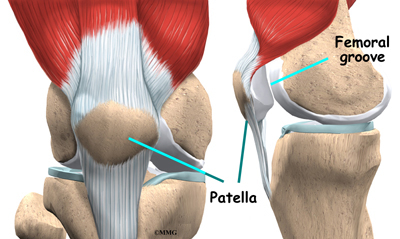
The patella moves up and down the femoral groove as you bend and straighten your knee. Learn more about patellofemoral anatomy here.
Alternatives
- Strengthening and stretching – The quadriceps and hip muscles play a critical role in stabilizing the patella. Weakness, imbalances, or a lack of flexibility can contribute to improper alignment and the development of PFPS [17,18]. Physical therapy exercises that improve muscle strength, control, and flexibility are one of the best ways to treat PFPS and its underlying causes [18].
- Knee compression sleeve – While they offer less support than a patellar stabilizer brace, compression sleeves can still help stabilize the patella and reduce patellar maltracking [18], which could help to manage PFPS along with the types of exercises mentioned above.
- Tri-compartment offloader – A TCO brace is the only type of knee brace that can offload the patellofemoral compartment. This means it can reduce pressure where the patella contacts the femur, which could relieve pain and discomfort from PFPS. A TCO can also help power your leg muscles by assisting knee extension, allowing you to improve your muscle strength and control without aggravating your symptoms. Strengthening will help improve patellar tracking and reduce your pain in the long run.
To learn more about different knee braces for patellofemoral pain, check out this resource – The Best Patellofemoral Knee Brace.

Spring Loaded Technology’s Levitation 2 is the world’s first tri-compartment offloader knee brace. It’s innovative design makes it an excellent choice of brace if you have osteoarthritis, a meniscus or ligament injury, or patellofemoral pain.
What Makes Levitation Unique?
Levitation can offload all three knee compartments at once to improve pain, mobility, and function like no other brace can. Some of its features include:
- Total pressure relief – Levitation can reduce joint forces in all three knee compartments by over 40% [5], which is equivalent to a level that would be achieved by losing 45 lbs of body weight [22].
- Rapid pain relief – By decompressing the entire knee joint, Levitation provides immediate and lasting pain relief from a variety of knee injuries and conditions.
- Added power – Levitation’s bionic hinge assists knee extension, powering your leg muscles so you can be active for longer and increase your leg strength. The amount of assistance can be adjusted to suit your needs.
Learn More
Check out the video below to see how the Levitation knee brace works.
How Do I Know if Levitation is Right For Me?
- Book a consultation with a bracing specialist – If you think Levitation might be the solution for your knee pain, please feel free to give us a call at 1.877.209.8780 to speak with a bracing specialist or click here to book a consultation at your convenience.
- Pricing and insurance – The cost of Levitation is covered by most insurance providers. The brace also comes with a 30-day risk-free trial. You can learn more about pricing and insurance coverage here, or speak to a bracing specialist for more information.
Learn More – Book Your Free Consultation Here
or give us a call at 1.877.209.8780
References
- Bryk, F. F., Jesus, J.F., Fukuda, T.Y., Moreira, E.G., Marcondes, F.B., Santos, M.G. (2011) Immediate effect of the elastic knee sleeve use on individuals with osteoarthritis. Rev Bras Reumatol. 2011 Sep-Oct;51(5):440-6.
- Richard Steadman, J., Briggs, K. K., Pomeroy, S. M., & Wijdicks, C. A. (2014). Current state of offloading braces for knee osteoarthritis. Knee Surgery, Sports Traumatology, Arthroscopy, 24(1), 42-50.
- Gohal, C., Shanmugaraj, A., Tate, P., Horner, N. S., Bedi, A., Adili, A., & Khan, M. (2018). Effectiveness of valgus offloading knee braces in the treatment of medial compartment knee osteoarthritis: A systematic review. Sports Health: A Multidisciplinary Approach, 10(6), 500-514.
- Hart, H.F., Stefanik, J.J., Wyndow, N., et al. (2017). The prevalence of radiographic and MRI-defined patellofemoral osteoarthritis and structural pathology: a systematic review and meta-analysis. B. J. Sports Med. 51(16): 1195-1208.
- McGibbon, C.A., Brandon, S., Bishop, E.L., Cowper-Smith, C.D., and Biden, E. (2020). Biomechanical study of a tricompartmental offloader brace for patellofemoral or multicompartment knee osteoarthritis. Frontiers in Bioengineering and Biotechnology, 8.
- Kalra, Mayank, Ryan Bakker, Sebastian S Tomescu, Anna M Polak, Micah Nicholls, and Naveen Chandrashekar. 2018. “The Effect of Offloader Knee Braces on Medial Meniscal Strain.” Prosthetics and Orthotics International 43 (2): 132–39.
- Doral, Mahmut Nedim, Onur Bilge, Gazi Huri, Egemen Turhan, and René Verdonk. 2018. “Modern Treatment of Meniscal Tears.” EFORT Open Reviews 3 (5): 260–68.
- Tsujii, Akira, Norimasa Nakamura, and Shuji Horibe. 2017. “Age-Related Changes in the Knee Meniscus.” The Knee 24 (6): 1262–70.
- Englund, Martin, Ali Guermazi, and L. Stefan Lohmander. 2009. “The Meniscus in Knee Osteoarthritis.” Rheumatic Disease Clinics of North America 35 (3): 579–90.
- Goebel, L., J. Reinhard, and H. Madry. 2017. “[Meniscal lesion. A pre-osteoarthritic condition of the knee joint]” Der Orthopäde 46 (10): 822–30.
- Tomescu, S., Bakker, R., Wasserstein, D., Kalra, M., Nicholls, M., Whyne, C., & Chandrashekar, N. (2018). Dynamically tensioned ACL functional knee braces reduce ACL and meniscal strain. Knee Surgery, Sports Traumatology, Arthroscopy, 26(2), 526–533.
- Welch T, Keller T, Maldonado R, et al. The effect of a dynamic PCL brace on patellofemoral compartment pressures in PCL-and PCL/PLC-deficient knees. J Exp Orthop 2017;4:10.
- LaPrade R.F., Smith, S.D., Wilson, K.J., et al. (2015). Quantification of functional brace forces for posterior cruciate ligament injuries on the knee joint: an in vivo investigation. Knee Surg Sports Traumatol Arthrosc, 23,3070–3076.
- Lavagnino, M., Arnoczky, S. P., Dodds, J., & Elvin, N. (2011). Infrapatellar Straps Decrease Patellar Tendon Strain at the Site of the Jumper’s Knee Lesion: A Computational Analysis Based on Radiographic Measurements. Sports Health: A Multidisciplinary Approach, 3(3), 296–302.
- de Vries, A., Zwerver, J., Diercks, R., Tak, I., van Berkel, S., van Cingel, R., van der Worp, H., & van den Akker-Scheek, I. (2015). Effect of patellar strap and sports tape on pain in patellar tendinopathy: A randomized controlled trial. Scandinavian Journal of Medicine & Science in Sports, 26(10), 1217–1224.
- Dar, G., & Mei-Dan, E. (2019). Immediate effect of infrapatellar strap on pain and jump height in patellar tendinopathy among young athletes. Prosthetics & Orthotics International, 43(1), 21–27.
- Smith, T. O., Drew, B. T., Meek, T. H., & Clark, A. B. (2015). Knee orthoses for treating patellofemoral pain syndrome. Cochrane Database of Systematic Reviews.
- Dutton, R. A., Khadavi, M. J., & Fredericson, M. (2014). Update on Rehabilitation of Patellofemoral Pain. Current Sports Medicine Reports, 13(3), 172–178.
- Arazpour, M., Notarki, T. T., Salimi, A., Bani, M. A., Nabavi, H., & Hutchins, S. W. (2013). The effect of patellofemoral bracing on walking in individuals with patellofemoral pain syndrome. Prosthetics & Orthotics International, 37(6), 465–470.
- Petersen, W., Ellermann, A., Gösele-Koppenburg, A., Best, R., Rembitzki, I. V., Brüggemann, G.-P., & Liebau, C. (2014). Patellofemoral pain syndrome. Knee Surgery, Sports Traumatology, Arthroscopy, 22(10), 2264–2274.
- Petersen, W., Ellermann, A., Rembitzki, I. V., Scheffler, S., Herbort, M., Brüggemann, G. P., Best, R., Zantop, T., & Liebau, C. (2016). Evaluating the potential synergistic benefit of a realignment brace on patients receiving exercise therapy for patellofemoral pain syndrome: a randomized clinical trial. Archives of Orthopaedic and Trauma Surgery, 136(7), 975–982.
- Budarick, A.R., MacKeil, B. E., Fitzgerald, S., and Cowper-Smith, C.D. (2020). Design evaluation of a novel multicompartment offloader knee brace. Journal of Biomechanical Engineering, 142(1).
- Brandsson, S., Faxen, E., Kartus, J., Eriksson, B.I., Karlsson, J. (2002). Is a knee brace advantageous after anterior cruciate ligament surgery? Scandinavian Journal of Medicine & Science in Sports, 11(2), 110-114.

